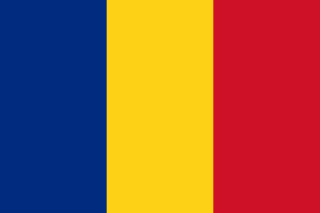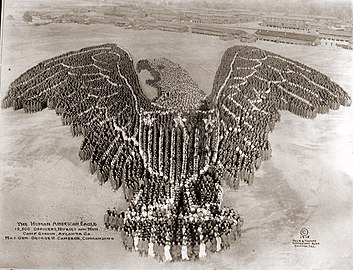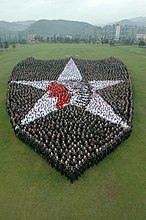Living photographs
Mole immigrated to the United States with his family in 1903, when he was 14 years old. He worked as a commercial photographer in Zion, Illinois, north of Chicago. During World War I, he traveled to various Army, Marine and Navy camps to execute his massive compositions. He is considered a pioneer in the field of performed group photography. [2] Executing photographs using such large numbers, and relying on lines of perspective stretching out more than a hundred meters, required a week of preparation and then hours to actually position the formations. Mole would stand on his viewing tower and shout into a megaphone or use a long pole with a white flag to arrange the tens of thousands of soldiers into position. [3]
Ten images are most famous from this period. They include images of Woodrow Wilson, the Liberty Bell, Statue of Liberty, the American Eagle as well as emblems of the YMCA and the Allied flags. The Human U.S. Shield required the placement of 30,000 people; The Liberty Bell 25,000. [4]
Mole's work is featured in the collections of the Chicago Historical Society, Metropolitan Museum of Art, [5] San Francisco Museum of Modern Art, and the Library of Congress. The photographs were again presented to the public in the July 2007 issue of Martha Stewart Living . Eight of the images are displayed in a feature article.
"Woodrow Wilson", 21,000 people
"The Human Liberty Bell", 25,000 people
"Human Statue of Liberty", 18,000 people
Approximation of "The Human Statue of Liberty" from directly above without
anamorphosis "The Human American Eagle", 12,500 people
YMCA emblem
"The Living Allied Flags"
"The Human US Shield", 30,000 people

The Statue of Liberty is a colossal neoclassical sculpture on Liberty Island in New York Harbor in New York City, in the United States. The copper statue, a gift from the people of France, was designed by French sculptor Frédéric Auguste Bartholdi and its metal framework was built by Gustave Eiffel. The statue was dedicated on October 28, 1886.

The national flag of Romania is a tricolour. The Constitution of Romania states that "The flag of Romania is tricolour; the colours are arranged vertically in the following order from the flagpole: blue, yellow, red". The flag has a width-length ratio of 2:3; the proportions, shades of colour as well as the flag protocol were established by law in 1994, and extended in 2001.

The Phrygian cap or liberty cap is a soft conical cap with the apex bent over, associated in antiquity with several peoples in Eastern Europe and Anatolia, including the Persians, the Medes and the Scythians, as well as in the Balkans, Dacia, Thrace and in Phrygia, where the name originated. The oldest depiction of the Phrygian cap is from Persepolis in Iran.

The national flag of Turkey, officially the Turkish flag, is a red flag featuring a white star and crescent from its emblem. The flag is often called "the red flag", and is referred to as "the red banner" in the Turkish national anthem. The current Turkish flag is directly derived from the late Ottoman flag, which had been adopted in the late 18th century and acquired its final form in 1844. The measures, geometric proportions, and exact tone of red of the flag of Turkey were legally standardized with the Turkish Flag Law on 29 May 1936.

The leather pride flag is a symbol used by the leather subculture since the 1990s. It was designed by Tony DeBlase, and was quickly embraced by the gay leather community. It has since become associated with leather in general and also with other kink and fetish subcultures such as the BDSM community.

The California State Capitol Museum consists of a museum in and grounds around the California State Capitol in Sacramento, California, United States. The building has been the home of the California State Legislature since 1869. The State Capitol Museum has been a property in the California State Parks system since 1982.

The Soldiers and Sailors Monument is a monument erected in Boston Common in downtown Boston, dedicated to soldiers and sailors of the Commonwealth of Massachusetts who died in the American Civil War. Designed by Martin Milmore, construction began in 1874 and the monument was dedicated on September 17, 1877. Union Generals George B. McClellan and Joseph Hooker were among the estimated 25,000 people attending the dedication on Boston Common.

Columbia, also known as Miss Columbia, is a female national personification of the United States. It was also a historical name applied to the Americas and to the New World. The association has given rise to the names of many American places, objects, institutions and companies, including the District of Columbia; Columbia, South Carolina; Columbia University; "Hail, Columbia"; Columbia Rediviva; and the Columbia River. Images of the Statue of Liberty largely displaced personified Columbia as the female symbol of the United States by around 1920, although Lady Liberty was seen as an aspect of Columbia. Columbia's most prominent display in the 21st Century is as part of the logo of the Hollywood film studio Columbia Pictures.

The national emblem of Indonesia is called Garuda Pancasila. The main part is the Garuda with a heraldic shield on its chest and a scroll gripped by its legs. The shield's five emblems represent Pancasila, the five principles of Indonesia's national ideology. The Garuda claws gripping a white ribbon scroll inscribed with the national motto Bhinneka Tunggal Ika written in black text, which can be loosely translated as "Unity in Diversity". Garuda Pancasila was designed by Sultan Hamid II from Pontianak, supervised by Sukarno, and was adopted as the national emblem on 11 February 1950.

Anamorphosis is a distorted projection that requires the viewer to occupy a specific vantage point, use special devices, or both to view a recognizable image. It is used in painting, photography, sculpture and installation, toys, and film special effects. The word is derived from the Greek prefix ana-, meaning "back" or "again", and the word morphe, meaning "shape" or "form". Extreme anamorphosis has been used by artists to disguise caricatures, erotic and scatological scenes, and other furtive images from a casual spectator, while revealing an undistorted image to the knowledgeable viewer.

The national emblem of Iran since the Iranian Revolution features four curves and a sword, surmounted by a shadda. It is very similar to the Sikh Khanda symbol. The emblem was designed by Hamid Nadimi, and was officially approved by Ayatollah Ruhollah Khomeini, the first supreme leader of Iran, on 9 May 1980.

The Liberty Bell Museum was a non-profit organization and museum located in Zion's United Church of Christ in Allentown, Pennsylvania in the Lehigh Valley region of eastern Pennsylvania. The museum was based in the church in which the Liberty Bell, an iconic and globally-recognized symbol of America's independence, was hidden from the British Army by Allentown-area American patriots during the American Revolutionary War from September 1777 to June 1778.

The Emblem of Tamil Nadu is the official state emblem of Tamil Nadu and is used as the official state symbol of the Government of Tamil Nadu.

Symbolism in the French Revolution was a device to distinguish and celebrate the main features of the French Revolution and ensure public identification and support. In order to effectively illustrate the differences between the new Republic and the old regime, the leaders needed to implement a new set of symbols to be celebrated instead of the old religious and monarchical symbolism. To this end, symbols were borrowed from historic cultures and redefined, while those of the old regime were either destroyed or reattributed acceptable characteristics. New symbols and styles were put in place to separate the new, Republican country from the monarchy of the past. These new and revised symbols were used to instill in the public a new sense of tradition and reverence for the Enlightenment and the Republic.

"İstiklâl Marşı" is the national anthem of both the Republic of Turkey and the Turkish Republic of Northern Cyprus. It was officially adopted by the Grand National Assembly on 12 March 1921—two-and-a-half years before the 29 October 1923 establishment of the nation—both as a motivational musical saga for the troops fighting in the Turkish War of Independence, and as an aspirational anthem for a Republic that was yet to be established.
Communist symbolism represents a variety of themes, including revolution, the proletariat, the peasantry, agriculture, or international solidarity. The red flag, the hammer and sickle and the red star or variations thereof are some of the symbols adopted by communist movements, governments, and parties worldwide.
Decommunization in Ukraine started during the dissolution of the Soviet Union in 1991 and expanded afterwards. Following the 2014 Revolution of Dignity and beginning of the Russo-Ukrainian War, the Ukrainian government approved laws that banned communist symbols, as well as symbols of Nazism as ideologies deemed to be totalitarian.

The Veterans Memorial Park located in Las Cruces, New Mexico was constructed by the Las Cruces Home Builders Association under the direction of the City and was dedicated May 5, 1999. In honor and memorial of the men and women who fought and served in the United States armed forces and in particular, those who served from Las Cruces area, the Veterans Memorial Park exhibits monuments to honor their sacrifices made over the course of history. The history recognized begins from as early as the American Revolutionary War to the present day. The Veterans Memorial Park is organized and guided with a trail that directs visitors to the various monuments scattered throughout the park.
The Circle of Heroes is an underwater military veterans memorial 10 miles off the coast of Honeymoon Island State Park in the Gulf of Mexico. It is the first underwater veterans memorial.

Soviet imagery has been extensively used by Russian forces during the Russo-Ukrainian War, especially following the invasion of Ukraine by Russia on 24 February 2022. Prior to 1991, Ukraine was a member republic of the Soviet Union.



























